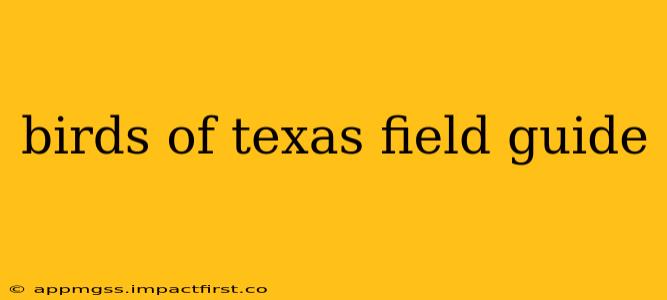Texas boasts incredible avian diversity, making it a birder's paradise. From the majestic bald eagle soaring overhead to the vibrant painted bunting flitting through the brush, the Lone Star State offers a spectacular array of bird species to observe and identify. This comprehensive guide will help you navigate the rich tapestry of Texas birds, equipping you with the knowledge to identify your feathered friends in the field.
What are some of the most common birds in Texas?
Texas's diverse habitats support a wide range of common bird species. Some of the most frequently encountered include:
- Northern Cardinal: This vibrant red bird is a year-round resident, easily recognized by its crest and cheerful song. You'll find them in a variety of habitats, from suburban yards to wooded areas.
- Mourning Dove: A ubiquitous sight across Texas, the mourning dove is known for its soft, mournful cooing. They're often seen foraging on the ground or perched on wires.
- American Robin: Another common year-round resident, the American robin is easily identified by its reddish-orange breast and cheerful song. They're often found in lawns and parks.
- House Sparrow: While not native, the House Sparrow is incredibly common in urban and suburban areas throughout Texas.
- Blue Jay: These noisy and boisterous birds are a common sight in wooded areas and parks, showing off their bright blue plumage.
This is just a small sample; many other common birds call Texas home. The specific species you encounter will depend on your location and the time of year.
What is the best time of year to go birdwatching in Texas?
The best time for birdwatching in Texas depends on your priorities. Spring and fall migrations bring a tremendous influx of birds, offering the chance to spot many species that are not present year-round. Spring, in particular, sees many breeding birds arriving and displaying their vibrant plumage. However, winter offers the chance to spot species that migrate south for the colder months. Summer can also be rewarding, with many resident birds raising their young.
Ultimately, the ideal time to go birdwatching depends on which species you're hoping to see and your tolerance for heat or cold.
What are some good places for birdwatching in Texas?
Texas offers a multitude of fantastic birdwatching locations, catering to various preferences. Here are a few examples:
- National Parks: Big Bend National Park and Guadalupe Mountains National Park offer stunning landscapes and a diverse range of species.
- State Parks: Texas boasts a vast network of state parks, many of which offer excellent birdwatching opportunities. Check the Texas Parks and Wildlife Department website for a complete list.
- Wildlife Refuges: Refuges like the Aransas National Wildlife Refuge provide critical habitats for many species, including the endangered whooping crane.
- Local Parks and Green Spaces: Even smaller parks and green spaces in urban areas can be surprising havens for birdlife.
What kind of equipment do I need for birdwatching in Texas?
While you can enjoy birdwatching with minimal equipment, having the right gear can significantly enhance your experience.
- Binoculars: A good pair of binoculars is essential for getting a closer look at birds. Choose binoculars with at least 8x magnification and a wide field of view.
- Field Guide: A comprehensive field guide specific to Texas birds will be invaluable for identifying the species you see. This guide itself can be a great starting point!
- Notebook and Pen: Keeping a record of your sightings, including date, location, and species, can be a rewarding way to track your birding progress.
- Camera (Optional): While not essential, a camera can allow you to capture photos of your favorite birds. A telephoto lens is helpful for getting close-up shots.
- Appropriate Clothing and Footwear: Texas weather can be variable, so dress in layers and wear comfortable, sturdy shoes suitable for walking in various terrains.
How can I identify birds in Texas?
Identifying birds requires careful observation and the use of reliable resources. Pay attention to the following:
- Size and Shape: Note the bird's overall size and shape, including the length of its wings and tail.
- Color and Pattern: Take note of the bird's plumage, including the color and pattern of its feathers.
- Behavior: Observe the bird's behavior, such as its foraging habits, flight patterns, and vocalizations.
- Habitat: The type of habitat where you find the bird can be a valuable clue to its identity.
- Field Guide: Use a field guide to compare your observations with illustrations and descriptions of various species.
This guide provides a foundational understanding of birdwatching in Texas. Remember to respect wildlife and their habitats. Happy birding!
